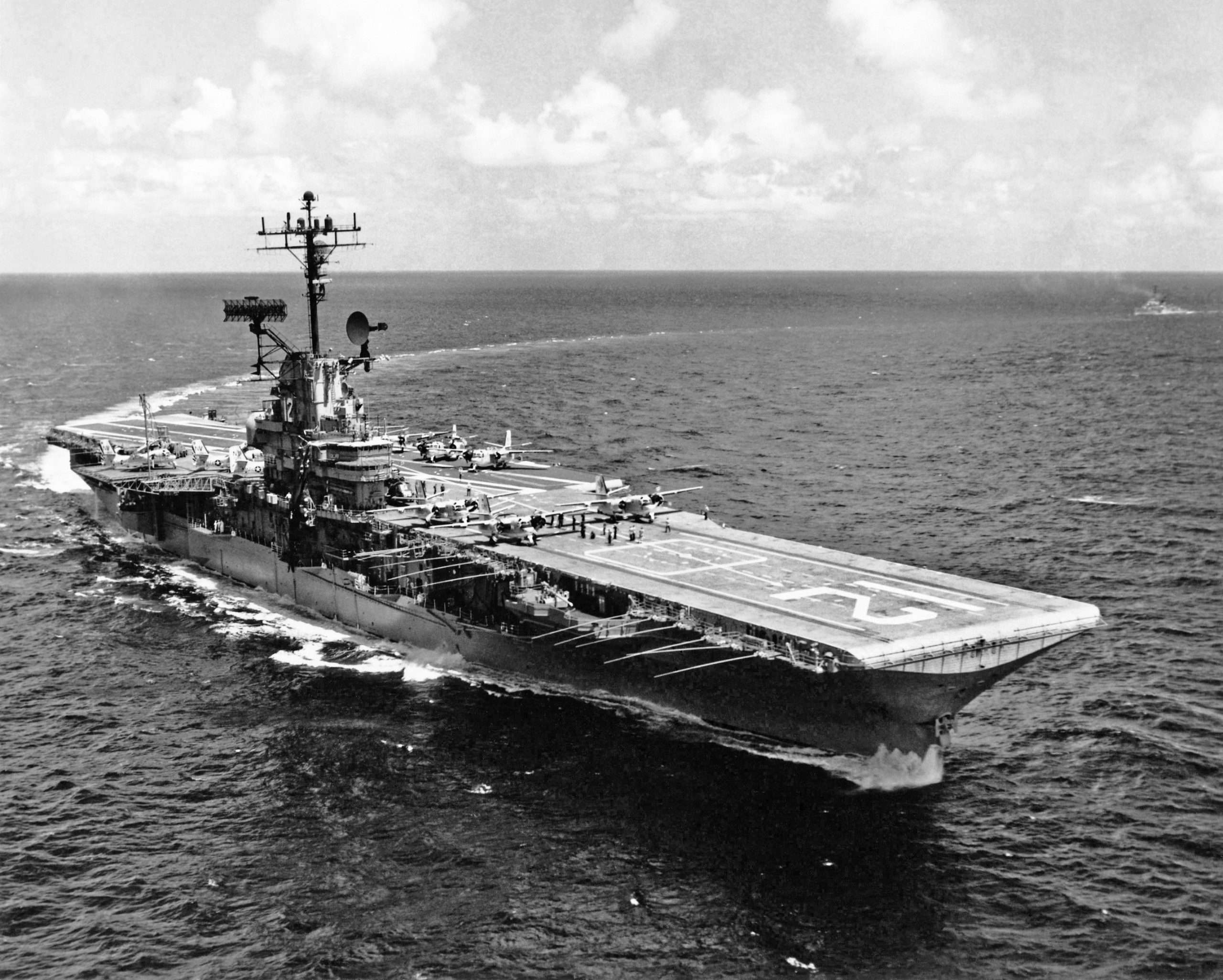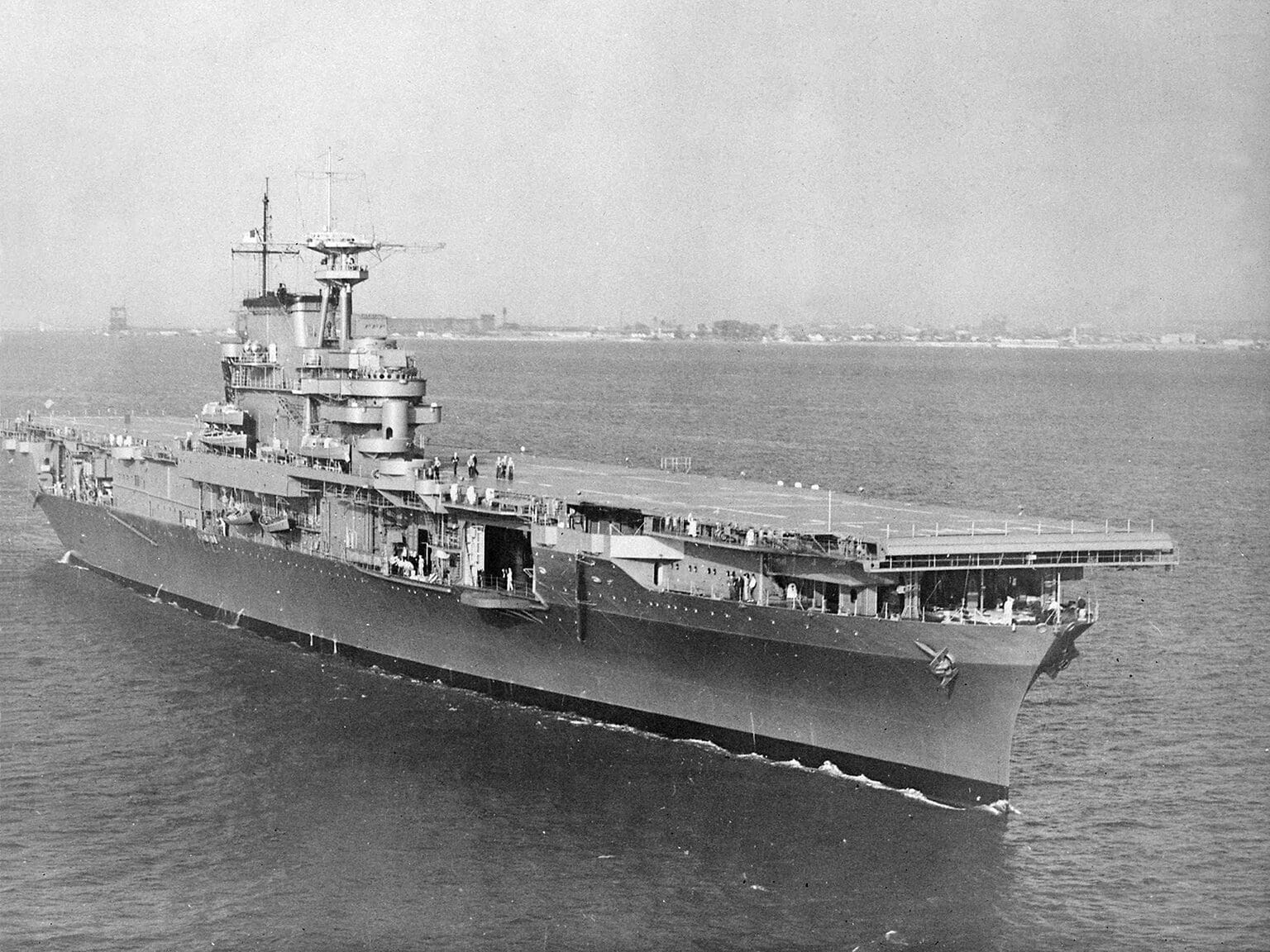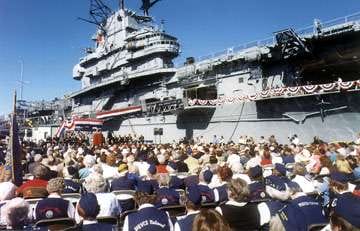Apollo Splashdown
This exhibition explores the space programs that flourished after WWII during America’s Space Race with the USSR and culminates with the Apollo 11 and 12 Moon landing which USS Hornet recovered after their splashdown in the Pacific Ocean. Artifacts include an early Grumman Corp. model for the Lunar Landing Module (known as the LEM), artifacts made and distributed to Hornet’s crew during the missions, and popular memorabilia of the time.
Captain Carl Seiberlich
(1921-2006)
Captain Carl Seiberlich was the Commanding Officer of USS Hornet CVS-12. He was also the Commander of all Pacific Ocean recovery forces for Apollo 11 (assigned to Task Force 130). As such, he was the “on scene” boss for the entire recovery operation, which was far more complicated than any previous spaceflight recovery.
A veteran of WWII, he was a seasoned skipper who was calm under pressure with excellent ship-handling and leadership skills. All great qualities when one has to contend with the never-before-done moon germ quarantine program, plus the onboard presence of President Nixon and his entourage, with a large number of print and TV media personnel and a live satellite TV broadcast to the world! As a historical note, Captain Seiberlich became the first graduate of the Merchant Marine Academy at King’s Point to attain flag rank in the US Navy.
In the Apollo 11 photo he is shown on the flight deck of the aircraft carrier being congratulated by President Nixon for a job well done, moments before the President departed by helicopter to continue his worldwide tour.
Comments
In an interview before he passed away, Captain Seiberlich said he felt privileged to have served his country for 37 years as a naval officer. He was extremely proud of how the ship’s crew executed a flawless recovery of Apollo 11 and Apollo 12. And, he felt greatly honored at being selected to place the exclamation mark at the end of President Kennedy’s challenge “to land a man on the Moon and return him safely to the Earth.”
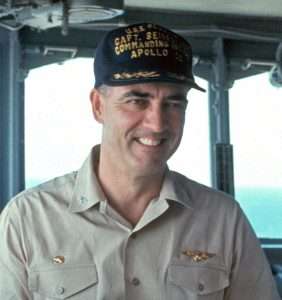
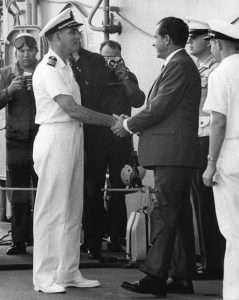
LCDR Charles Larson
(1936 – 2014)
LCDR Charles Larson was the Naval Aide to President Nixon in 1969. As such, he was the assigned “trip officer” for this segment of the President’s worldwide tour. He had to coordinate with many organizations besides the Navy – NASA, Secret Service, HMX-1 Squadron, White House Communications Agency, and Air Force among them – to ensure all logistical preparations were in order for the only Presidential visit to a spacecraft recovery ship in history. Whenever one sees a video or photograph of President Nixon on the USS Hornet, LCDR Larson is within a few feet of him.
LCDR Larson was highly respected officer and had a very successful career as a naval aviator and submariner. He eventually rose to the rank of 4-star admiral and Commander of the US Pacific Command. He also served two tours of duty as the Superintendent of the US Naval Academy, where he is buried today next to his good friend and USNA classmate, Senator John McCain.
The Apollo 11 photo was taken at 5:30am (30 minutes before splashdown) on USS Hornet hangar deck while President Nixon is being briefed about the MQF portion of the quarantine program by NASA’s quarantine team leader John Stonesifer.
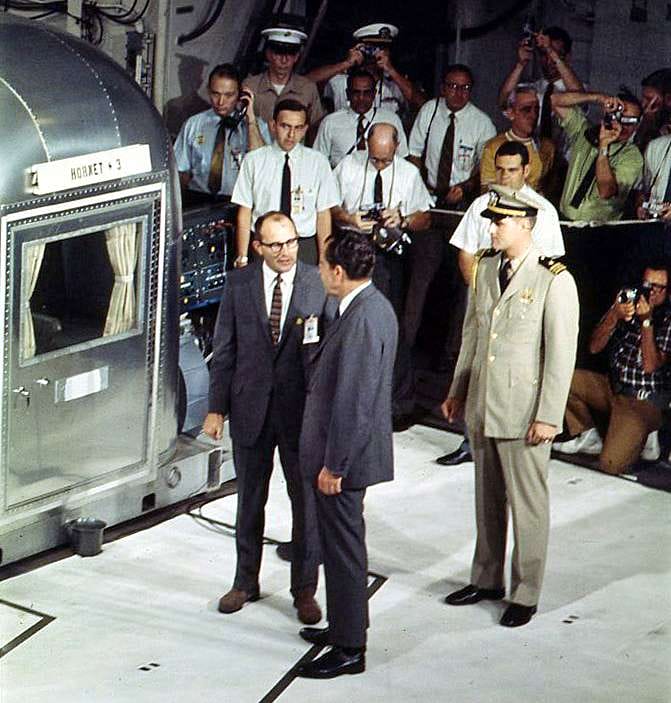
CDR Donald Jones
(1928 – 2004)
CDR Donald Jones was the Commanding Officer of Helicopter Antisubmarine Squadron Four (HS-4) stationed at Imperial beach, CA in 1969. The squadron was known as the “Black Knights” and wore berets when not flying their Sikorsky SH-3 Sea King helicopters. As the CO of HS-4, CDR Jones was tasked by NASA with developing night and all-weather astronaut recovery procedures for the Apollo program.
For that reason, he was selected as the primary recovery pilot for the epic Apollo 8 and Apollo 11 missions, the first to orbit humans around the Moon and the first to land humans on the Moon. The famous helicopter #66 was the astronaut recovery aircraft for all five Apollo missions handled by HS-4 (8, 10, 11, 12, and 13). During his aviation career, CDR Jones flew over six thousand hours in twenty different aircraft types and made over two thousand landings aboard ships of all classes. He eventually achieved the rank of Vice Admiral before retiring.
The Apollo 11 photo was taken in the hangar deck immediately after the astronauts had landed on the USS Hornet and were still being towed into the hangar deck. The person in the brown suit is Senior Public Affairs Officer for NASA, Ben James, who is escorting pilot CDR Jones and co-pilot LTjg Johnson to the media area for TV interviews.
Comments
“Being involved in the Apollo 8 and 11 recoveries were the highlights of my Navy career. I felt the HS-4 “Black Knights” squadron performed in an exceptional manner, and we’re very proud to have participated in this epic adventure for America and all mankind.”
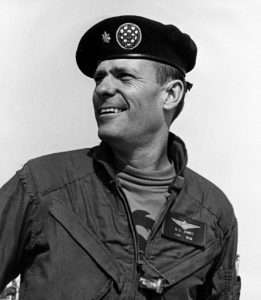
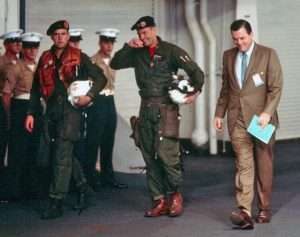
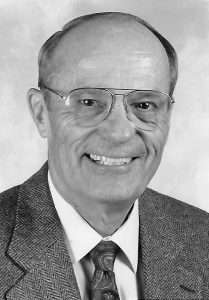
Navy UDT LT Clancy Hatleberg
As a commissioned officer, Clancy Hatleberg served in the US Navy for 20 years, primarily in the Underwater Demolition Teams community (who are now called SEALs).
During the Apollo 11 recovery mission, Clancy was the UDT Team Leader and decontamination swimmer. As such he coordinated the post-splashdown spacecraft stabilization response and provided the first line of defense in preventing potential contamination of the Earth by lunar pathogens. He performed spacecraft and astronaut decontamination procedures while wearing a NASA biological isolation garment (BIG suit) himself. He then assisted the 3 astronauts with being hoisted up into their recovery helicopter to be flown back to the USS Hornet.
The Apollo 11 recovery photo shows Clancy in his BIG suit standing on the flotation collar of the Columbia spacecraft, after helping the astronauts into the raft and closing the hatch. The 3 astronauts, also wearing BIGs, are sitting in the raft waiting to be wiped down with a decontamination agent prior to being flown to the USS Hornet. In the front is Buzz Aldrin, in the middle is Mike Collins and in the rear is Neil Armstrong.
Comments
“I was honored to be part of the Navy/NASA team that brought the Apollo 11 astronauts home safe – and proud we did.
As a Naval Special Warfare Officer, I had learned never to quit on myself or give up on my team mates and always complete the operation. As part of the Apollo 11 recovery, where failure was not an option, I learned the NASA way, keep practicing what you’re good at and always complete the procedure.
Taken together, I had my answer to a “life” question. Because, if you never quit on yourself, give up on your team mates, do what you do best, and complete the task at hand, then failure can never be an option in your life. On a personal note, as combat swimmers, being part of the recovery was very special. We had just come back from combat in Vietnam, some of us with embedded metal souvenirs. Having answered America’s call to duty, we found ourselves not welcomed back. So, having kept the astronauts safe while in our care, NASA gave us permission to feel good about ourselves again. And, we did.”
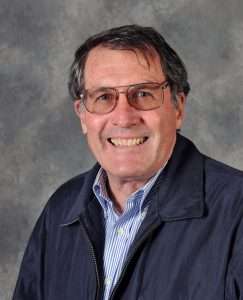
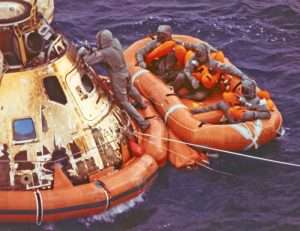
LTjg Bruce Johnson
LTjg Bruce Johnson was a young naval aviator when he joined Helicopter Antisubmarine Squadron Four (HS-4) stationed at Imperial beach, CA in 1969. The squadron was known as the “Black Knights” and wore berets when not flying their Sikorsky SH-3 Sea King helicopters.
LTjg Johnson was assigned as co-pilot for the astronaut helicopter, call-sign Recovery 1, known to space fans as “#66” because of the 5 Apollo recoveries it performed. During the recovery flight, he monitored all aircraft systems to ensure they were operating within limits, that the proper location, altitude and attitude were within NASA desired limits. From the co-pilot’s seat in the cockpit, he visually monitored the safe retrieval of each astronaut as they were hoisted aboard and secured in the cargo bay.
Due to the worldwide live TV coverage, and President Nixon’s presence, on the short flight back to USS Hornet, he repeatedly ensured the landing gear was down and locked in the landing position to avoid an embarrassing mishap on the flight deck!
The Apollo 11 photo was taken just after helo #66 had touched down on Hornet flight deck with the astronauts in back. LTjg Johnson, in the cockpit seat on the right, is reading off the landing and shutdown checklist for pilot CDR Don Jones in the left (nearest) seat.
Comments
“Being part of the Apollo 11 mission was definitely one of the highlights of my life. Only seeing my children and grandchildren born would surpass this event. It has been my 15 minutes of fame and I have really enjoy participating all the reunions and sea stories from all the participants of this event.”
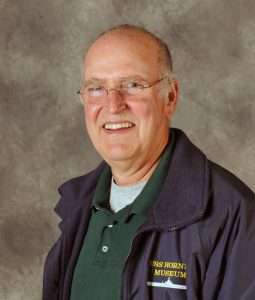
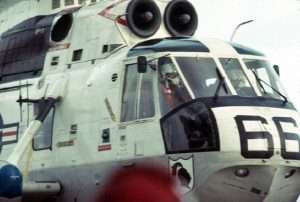
PHC Milt Putnam
PHC Milt Putnam was a combat photographer assigned to Helicopter Antisubmarine Squadron FOUR (HS-4) stationed at Imperial beach, CA in 1969. The squadron was known as the Black Knights and wore berets when not flying their Sikorsky SH-3 Sea King helicopters. Milt had been assigned as the Navy’s airborne photographer for the Apollo 8 and Apollo 10 recovery missions and was well prepared to handle this assignment again for Apollo 11.
NASA wanted both photograph and video records of the astronaut’s recovery from the spacecraft. NASA assigned videographer Lee Jones who had recorded many recoveries before. He filmed some of the sequences shown in Apollo 11: Quarantine – as the astronauts exited their spacecraft into the life raft, were scrubbed by the UDT swimmer, and were hoisted into the Recovery 1 helicopter by Billy Pugh net.
The Navy assigned PHC Putnam to handle the still photographic record. One hour before the Apollo 11 splashdown, four HS-4 Sea King’s took off from the USS Hornet. Sea King helicopter #70 using the call-sign Photo, carried the two photographers. PHC Putnam had 8 Nikon cameras strapped around his neck. Most were loaded with B&W film since they would be broadcast to newspapers around the world via the Associated Press (AP) and United Press International (UPI) wire services, which could not handle color.
Moments after splashdown, Photo was assigned to hover near the spacecraft at 40 feet in altitude, while the two photographers sat in the open door (hatch) on the left side of the helicopter. In this Apollo 11 photo taken during a SIMEX, you can see the two men as they practice getting the best lighting and shooting angles for their assignment.
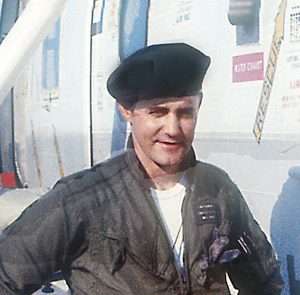
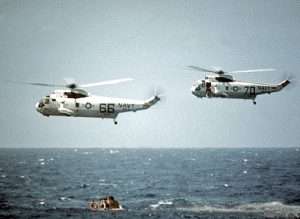
Navy UDT SN John Wolfram
There were two UDT swim teams deployed in HS-4 Sea King helicopters for the recovery of Apollo 11. Swim Team One in helicopter #53 was the first team on the scene as Columbia splashed down. They remained in the helicopter while the command module was in “stable 2” position, meaning upside down. For various reasons, Swim Team Two in helicopter #64 was called in to deploy into the water and stabilize the spacecraft. Although the sea state was higher than expected, Seaman John Wolfram was the first swimmer to leap from the helicopter into the water. He was only 20 years old and fresh out of basic UDT training.
He swam to the drifting spacecraft and attached a sea anchor to it to slow down its drift rate. Two other UDT swimmers then joined him (LTjg Wes Chesser and QM3 Mike Mallory), put a flotation collar around the command module and inflated two Navy life rafts. These were work rafts, one for equipment and the other for decontamination of the astronaut’s BIG suits, so they could be hoisted up into the recovery helicopter.
The swimmers then prepared the command module for its retrieval by the USS Hornet “Boat and Aircraft” crane later that morning. In the Apollo 11 photo, SN Wolfram is standing on top of the spacecraft, positioning its recovery loop and preparing for the B&A crane’s lifting cable to descend so it can be hooked to the loop. And, yes, he put some bathtub appliques on his wetsuit so his mother could identify him on TV!
Comments
“Little did I know that when I enlisted in the US Navy after high school graduation (1967), the next four years would be so crammed-full with adventure. My two tours in Vietnam during the war and my involvement in the Apollo 10 and 11 space recoveries have left enduring memories. Being the first human to touch the returned Apollo 11 spacecraft and get a thumbs-up from astronauts Neil Armstrong, Buzz Aldrin and Michael Collins was very special.”
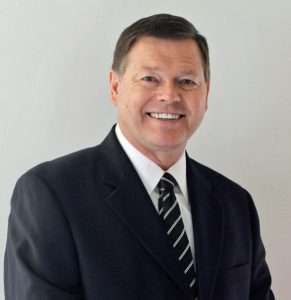
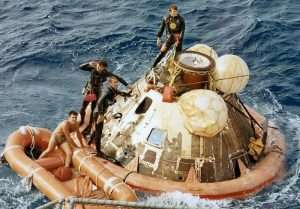
NASA Recovery Operations Team Leader Don Stullken
(1920-2009)
Don “Doc” Stullken was a WWII and Korean war Navy veteran and helped develop compact survival equipment packages for naval aviators. He joined NASA in 1961 and served as Chief of Recovery Operations Branch for the Mercury, Gemini, Apollo, Skylab, and ASTM Missions. He designed the “Stullken” flotation collar, to stabilize and buoy the spacecraft after splashdown.
Don was the Recovery Operations Team Leader for Apollo 11 while John Stonesifer managed the quarantine portion of the program. As such, Don worked closely with USS Hornet’s crew to ensure they understood the specific procedures required for a flawless recovery. The various recovery teams – aviators, navigators, UDT swimmers, medical personnel and ship’s crew practiced every aspect of the astronaut and spacecraft recovery procedures for two weeks, night and day for 8 days. At the end, everyone knew their job and there was a backup person for every activity, such as lifting the spacecraft out of the water by B&A crane or by Tilley crash crane.
The first Apollo 11 photo shows Don sitting in front of the MQF aboard USS Hornet, chatting with Neil Armstrong just before arrival in Pearl Harbor and the chaos of reentering the “real world” that ensued. The second shows Don as he personally moves the stairway close to the helicopter so the astronauts can exit while the TV cameras and reporters prepare to broadcast this event around the world. Don was very excited to have “his guys” back safely and wouldn’t wait for any of 1,000 young and strong sailors to move the steps!!
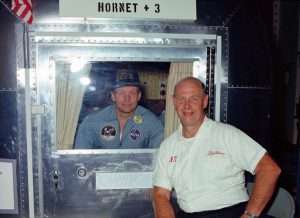
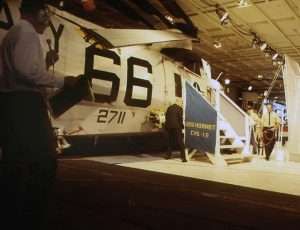
NASA Quarantine Team Leader John Stonesifer
There were two NASA Recovery Team leaders for Apollo 11 – Don Stullken handled the normal recovery operations while John Stonesifer managed the quarantine process.
As part of the Landing and Recovery Division, John was engaged in the training of worldwide DoD recovery forces assigned to support many flights. He served as the NASA Team Leader aboard a Navy recovery ship for a dozen recoveries during the Mercury, Gemini and Apollo programs.
During the Apollo 11 mission, John was the NASA Team Leader responsible for ensuring the performance of all required quarantine procedures. These procedures and special equipment (Mobile Quarantine Facility, Biological Isolation Garments and decontamination solutions) were developed to protect the Earth’s environment from the introduction of possible harmful lunar pathogens (popularly referred to as “moon germs”). He also had an “unpublicized” function! That was to alert the President’s Secret Service detail if the quarantine protocol had been broken, so President Nixon could evacuate the ship immediately.
The first Apollo 11 recovery photo shows John briefing President Nixon at 5:30am on the MQF portion of the NASA quarantine program. The second photo shows both Don Stullken and John Stonesifer in their business suits as the astronauts deplane the helicopter in the USS Hornet hangar deck. Don waved at them from their right side (back to the camera) while John greeted them from their left side. The astronauts are wearing their BIG suits, with Mike Collins nearing the MQF, followed by Neil Armstrong, and then Buzz Aldrin who is waving back at Don.
Comment
“During our time in high school and college, human space travel was unheard of. We at NASA did our best to accept the surprise challenge laid down by President Kennedy in 1961. For me, it was an incredible privilege to help identify and create successful space flight operations. I often say I had the best job in NASA, getting to know these brave astronauts and bringing them home safely.”
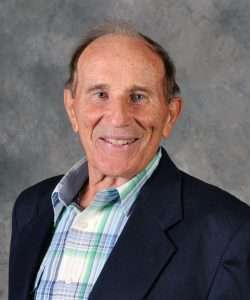
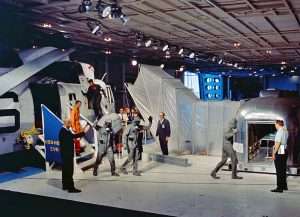
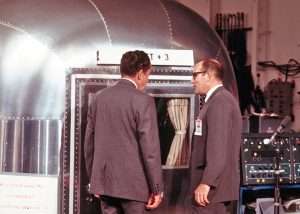
NASA Flight Surgeon Dr. William Carpentier
Dr. William Carpentier was assigned as the NASA flight surgeon for many Gemini and Apollo spaceflight recovery missions.
On splashdown day for Apollo 11, he was in the Recovery 1 Sea King helicopter. As the astronauts were hoisted up from the ocean one-by-one (Armstrong, Collins and then Aldrin), Dr. Carpentier helped them out of the recovery net into the cargo hold. He used hand signals to see if they were okay. They were encased in BIG suits, the tropic air was very humid, their visors had fogged up and the bobbing in the raft had made things very dicey. The engine fuel smell that permeated the helicopter made matters worse. Had the quarantine been broken, due to sea sickness or even a rip in a BIG suit, he was to immediately radio the USS Hornet so President Nixon and his entourage could depart immediately by HMX-1 helicopter.
Upon returning to the Hornet, he exited the helicopter behind the three astronauts and entered the MQF with them. He was locked inside the MQF with them for the 3 days it took to get back to the NASA JSC Lunar Receiving Lab, performing various health checks. He then spent the rest of the quarantine in the LRL, supporting additional astronaut medical evaluations. Bill also was the assigned physician for the astronaut’s worldwide tour later in the fall.
The Apollo 11 recovery photo shows Bill in an orange flight suit as he finishes herding the BIG suited astronauts into the MQF. He is preparing to close the door as soon as Buzz Aldrin is fully inside. Dr. Clarence Jernigan is holding the door – he will be the NASA flight surgeon for Apollo 12. Michael Collins entered first, followed by Neil Armstrong and then Buzz Aldrin.
Comments
“I feel very fortunate and honored to have had the opportunity of participating in one of the greatest technological achievements in the history of mankind!
My advice to the younger generation is to never pass up an opportunity to learn something new. Every fact I ever learned, and every skill I ever acquired, has been useful in facing challenges and solving problems throughout my life.
An important legacy of the Apollo program are the photographs taken of the earth. As Steven Hawking wrote, “When we see the earth from space, we see ourselves as a whole. We see unity and not division. It is such a simple image with a compelling message; one planet, one human race.”
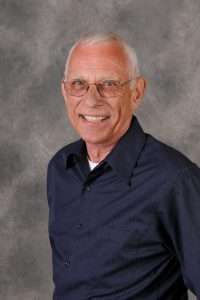
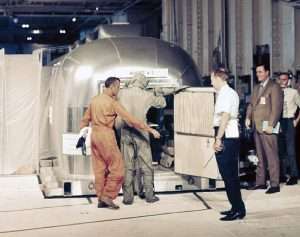
NASA MQF Technician John Hirasaki
John Hirasaki joined the NASA Landing and Recovery Division a year after graduating from college. Among other tasks, he was assigned to the test and evaluation process of the Mobile Quarantine Facility (MQF) for its sea trials and air transport. John was selected to be the Apollo 11 MQF Technician by drawing straws with 3 other individuals vying for that honor, all knowing that if there were toxic lunar pathogens, their life was over. During the Apollo 11 mission, he helped microwave the pre-prepared meals inside the MQF, managed the overall operation of the trailer, set up phone calls for the astronauts, etc. He was the first person on Earth to enter the Apollo spacecraft to retrieve key items such as the moon rocks and cameras, etc. He packaged the moon rocks for their flight back to the Lunar Receiving Laboratory at JSC in Houston. His first impression upon entering the moondust covered cabin was it smelled like exploded fireworks on the 4th of July. The first Apollo 11 photo shows John inside the MQF with a video camera, preparing to record the astronaut’s entrance, a sequence featured prominently in the Apollo 11: Quarantine documentary. The second one was selected because it is the best photobomb in the history of photography! Can you imagine standing behind the first two humans in history who walked on the Moon just days ago, and ignoring them as you look for your wife in the crowd of admirers outside? Now that’s “final rose” material!Comments
“Like every person who worked on the Apollo 11 mission, I felt honored to be a participant in that historic undertaking. The support of the American public for the Apollo Program also contributed to its success. In the future, I hope we will use the lessons learned from the Apollo Program to accomplish even greater technological feats.”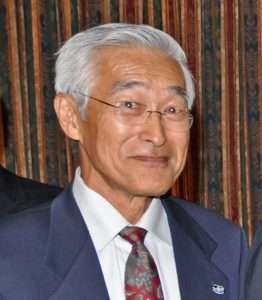
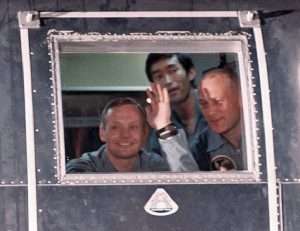
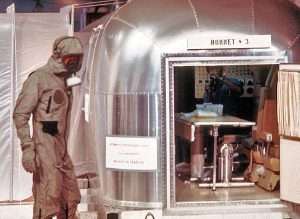
USS Arlington AGMR-2
Unknown to the public, there was a mystery ship involved with the Apollo 11 recovery. In fact, USS Arlington was actually much closer to the point of impact when Columbia splashed into the ocean than USS Hornet!
Arlington was a Major Communications Relay Ship that had formerly been a light aircraft carrier. For the Vietnam War, she had been converted to a floating message relay ship with powerful transmitters and receivers as well as a satellite terminal. She provided reliable communications handling capabilities for the 7th fleet during the Vietnam War.
To aid in the Apollo 11 recovery, she was released from Tonkin Gulf and steamed at high speed to the splashdown location 920 miles southwest of Hawaii. Upon arrival she provided valuable backup communications capability for Hornet. Additionally, she served as the overnight “hotel” for President Nixon and his entourage, who did not want to interfere with critical pre-splashdown preparations on Hornet. They Presidential group flew from Johnston Island by HMX-1 helicopters and arrived the evening before splashdown. They flew over to Hornet at 5am on July 24, just 1 hour before the spacecraft hit the water. And, in doing so, they gave up a ringside seat to the splashdown!
USS Hornet had been requested to maintain a 12-mile distance from the splashdown point, upwind of the descending command module, as it vented its internal cabin air into the atmosphere. This air contained a lot of moondust. Neither NASA nor the Secret Service wanted that contaminated air to fall on President Nixon. Arlington had no such restriction, so CO Captain Hugh Murphree positioned her only two miles away from where the spacecraft was going to hit the water.
The first Apollo 11 photo shows President Nixon, after egressing his Marine One helicopter, being greeted by Captain Murphree. The second one, taken from the Hornet flight deck, shows Arlington as the spacecraft is nearing splashdown (center) and one of the helicopters is rushing to the site (upper left). It is likely this dramatic photo has never been published before.
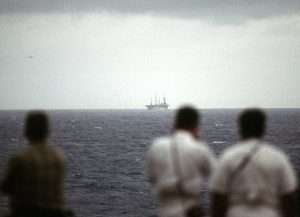
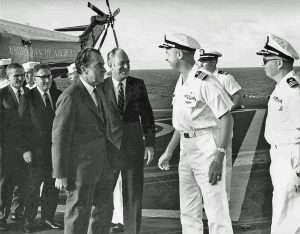
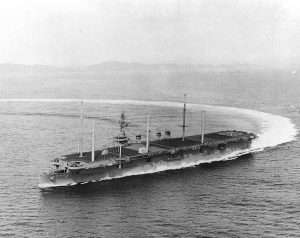
President Richard Nixon
The context for President Nixon’s becoming part of the Apollo 11 recovery program has to be viewed in a larger perspective. He was just starting his worldwide diplomatic tour to try and arrange peace talks for the Vietnam War, and to boost public opinion in the US. The White House believed the successful lunar landing mission fostered significant prestige and goodwill for America throughout the world and wanted to capitalize on that. Hence, the “Operation Moonglow” diplomatic visits to 8 countries. Eventually, this tour altered the course of the Cold War.
On July 23, the President and his entourage flew from San Francisco to Honolulu and then on to Johnston Island in Air Force One. (photo 1) From there, they were ferried about 200 miles to the Apollo 11 “end of mission” location in HMX-1 squadron helicopters. Their lodging for the night was on USS Arlington (AGMR-2) with President Nixon spending the night in Commanding Officer Captain Hugh Murphree’s stateroom. (photo 2)
The next morning, they flew 10 miles to Hornet, arriving at 5:12am, 40 minutes before splashdown. (photo 3) The President was taken to Hangar Bay 2 and given a briefing on the quarantine equipment and protocols by NASA’s John Stonesifer. (photo 4) He then went up to the Flag Bridge, where he waited for the splashdown to occur. As a naval officer in WWII, he was in an exuberant mood, trading jokes with sailors on the flight day below and reminiscing with CINCPAC Admiral John S. McCain, whose son was at that time a POW in North Vietnam. (photo 5)
At 5:50am, a double sonic boom washed over the flight deck to announce the impending arrival of the spacecraft, the astronauts, and a very expensive batch of moon rocks.
The President watched the astronaut recovery process from the Flag Bridge, flanked by NASA Administrator Thomas Paine and Admiral John S. McCain. (photo 6) Soon after the astronauts had been ensconced in the MQF, President Nixon wanted to go greet them but was restrained by Captain Seiberlich who explained that medical tests, and some showers, had to be completed first.
About one hour later, President Nixon strode into Hangar Bay 2 and approached the front of the MQF. He bantered with the astronauts, welcomed them home to Earth, promoted the two military men and invited them to a formal dinner at the White House. (photo 7)
Soon thereafter, he and his entourage left the hangar deck and made their way to the flight deck. After greeting some officers and crew, telling them “job well done,” he boarded Marine One. He gave his traditional hand salute on the steps and then was off, headed back to Johnston Island where Air Force One was waiting to fly the next leg of the “Operation Moonglow.” (photo 8) He had been on Hornet about 3 hours.

